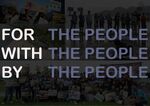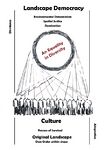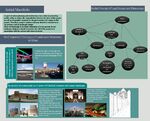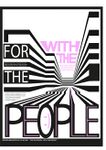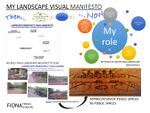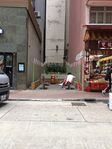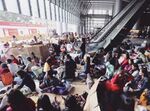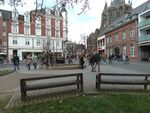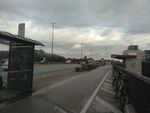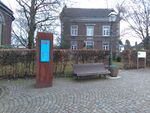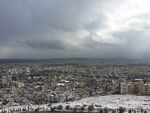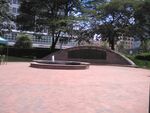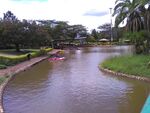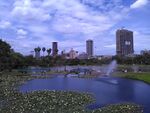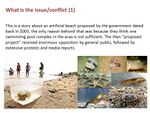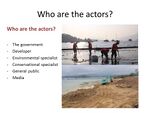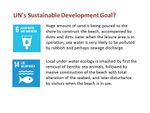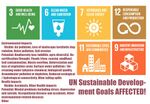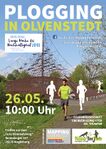LED Online Seminar 2018 - Working Group 8: Difference between revisions
| (69 intermediate revisions by 6 users not shown) | |||
| Line 28: | Line 28: | ||
'''A: Landscape and Democracy''' | '''A: Landscape and Democracy''' | ||
Lynch, Kevin. (1960): The Image of the City, Cambridge, Mass.: MIT Press (STEFAN FROM MAGDEBURG / GERMANY) | Lynch, Kevin. (1960): The Image of the City, Cambridge, Mass.: MIT Press (STEFAN FROM MAGDEBURG / GERMANY) | ||
Burckhardt, Lucius (1979): Why is landscape beautiful? in: Fezer/Schmitz (Eds.) Rethinking Man-made Environments (2012)(Sudhara) | Burckhardt, Lucius (1979): Why is landscape beautiful? in: Fezer/Schmitz (Eds.) Rethinking Man-made Environments (2012)(Sudhara) | ||
'''B: Concepts of Participation''' | '''B: Concepts of Participation''' | ||
Davis, Mike (1990): Fortress Los Angeles: The Militarization of Urban Space , From: City of Quartz: Exca (Fiona) | Davis, Mike (1990): Fortress Los Angeles: The Militarization of Urban Space , From: City of Quartz: Exca (Fiona) | ||
| Line 39: | Line 42: | ||
'''C: Community and Identity''' | '''C: Community and Identity''' | ||
Gafford, Farrah D. (2013): It Was a Real Village: Community Identity Formation Among Black Middle-Class Residents in Pontchartrain Park, Journal of Urban History 39:36 (HO SIN YEE) | Gafford, Farrah D. (2013): It Was a Real Village: Community Identity Formation Among Black Middle-Class Residents in Pontchartrain Park, Journal of Urban History 39:36 (HO SIN YEE) | ||
| Line 47: | Line 51: | ||
'''D: Designing''' | '''D: Designing''' | ||
Massachusetts Institute of Technology (2013): Places in the Making: How Placemaking Builds Places and Communities (HO SIN YEE) | Massachusetts Institute of Technology (2013): Places in the Making: How Placemaking Builds Places and Communities (HO SIN YEE) | ||
| Line 57: | Line 62: | ||
'''E: Communicating a Vision''' | '''E: Communicating a Vision''' | ||
Goldstein, B. E., A. T. Wessells, R. Lejano, and W. Butler. 2015. Narrating Resilience: Transforming Urban Systems Through Collaborative Storytelling. Urban Studies. 52 (7): 1285-1303. (HO SIN YEE) | Goldstein, B. E., A. T. Wessells, R. Lejano, and W. Butler. 2015. Narrating Resilience: Transforming Urban Systems Through Collaborative Storytelling. Urban Studies. 52 (7): 1285-1303. (HO SIN YEE) | ||
'Reading the Landscape' by Simon Bell, EMU Tartu (Sudhara) | |||
'''Games in urban planning examples''' | '''Games in urban planning examples''' | ||
Stadtspieler: http://www.stadtspieler.com (STEFAN FROM MAGDEBURG / GERMANY) | Stadtspieler: http://www.stadtspieler.com (STEFAN FROM MAGDEBURG / GERMANY) | ||
Block By Block: http://blockbyblock.org/about (STEFAN FROM MAGDEBURG / GERMANY) | Block By Block: http://blockbyblock.org/about (STEFAN FROM MAGDEBURG / GERMANY) | ||
| Line 80: | Line 87: | ||
'''Concepts and definitions''' | '''Concepts and definitions''' | ||
''' | '''HO SIN YEE (Alisa)''' | ||
*...... | *(C: Community and Identity) (Gafford, Farrah D. (2013): It Was a Real Village: Community Identity Formation Among Black Middle-Class Residents in Pontchartrain Park, Journal of Urban History 39:36) | ||
*....... | |||
*....... | CONCEPT ONE: Community and identity building depends strongly on shared childhood and adolescent memories among individuals, which are created by attending religious, cultural and family functions within the neighborhood. The resulted communal bonding can be long-lasting, and it plays an important role in the resilience of a community after traumas. | ||
*(D: Designing) (Massachusetts Institute of Technology (2013): Places in the Making: How Placemaking Builds Places and Communities) | |||
CONCEPT TWO: Placemaking is more about doing it but not just focusing on the planning phase. It is about trial and error, as well as improvement, which make it more powerful than the seemingly best planned solution. One important thing to note is the making process never ends, as it involves the actual usage and maintenance after the accomplishment of design and construction. | |||
*(E: Communicating a Vision) (Goldstein, B. E., A. T. Wessells, R. Lejano, and W. Butler. 2015. Narrating Resilience: Transforming Urban Systems Through Collaborative Storytelling. Urban Studies. 52 (7): 1285-1303. ) | |||
CONCEPT THREE: Shared vision and experience among a place are enhanced by planning with different ways of understanding. Therefore, narrative is a good way to address the symbolic and subjective meanings of wellbeing, which enforcing the ability to gather various opinions and allowing self-initiated processes to decide what improvements should be done for whom. | |||
'''Sudara Jayalath: ...''' | |||
*'''Concept ONE''' (''A:landscape democracy;mapping the terrain)_Burckhardt, Lucius (1979): Why is landscape beautiful? in: Fezer/Schmitz (Eds.) Rethinking Man-made Environments (2012'') | |||
'''Existence of a Landscape:''' "Landscape is a Construct". There is no 'absolute objective reality', where an absolute landscape exists.The existence of a landscape is relative, its relative to the perception of the observer. Perception of the observer is a production of his/her own memory, experience and knowledge. But the knowledge is a production of a particular epistemology which structured out via a specific way of thinking due to a specific cultural conditions, which are defined by landscapes. | |||
*'''Concept TWO''' ''(D:Designing)_ Hester, Randolph: Life, Liberty and the Pursuit of Sustainable Happiness | |||
'''Resilient Form:''' Adaptability, bare-ability of a human habitat called as a resilient form. A human habitat could exist in various forms according to temporal land utilization. Due to evolution of utility, functional conception or natural state a habitat have to adapt for the next state of existence. For this existing form is important. A habitat with this adaptable form can be called as a resilient form. | |||
*'''Concept THREE''' ''(E:Communicating a Vision)_'Reading the Landscape' by Simon Bell, EMU Tartu'' | |||
'''Landscape Character:''' Landscape is a process, series of situations, which take place one after one in to a particular order. This order has a unique, or spot specific behavior which reflects (characterize) via each situation. Each situation projected out as a combination of different layers which are dependent on each other. As some examples Geological, Geo-morphological, Ecological, Anthropological, Communication, Visual and so on. The character of a landscape is the condition, dominate characteristics of each layer in a particular time. | |||
'''Author 3:Stefan Köder''' | |||
*'''CONCEPT ONE: Concept "Five Elements" (1960) by urban theorist Kevin Lynch'''(A: Landscape and Democracy) (Lynch, Kevin. (1960): The Image of the City, Cambridge, Mass.: MIT Press) | |||
Study how observers take in information of the city, and use it to make mental maps. Lynch's conclusion was that people formed mental maps of their surroundings consisting of five basic elements | |||
Lynch's Five Elements: | |||
1) Paths | |||
These are the streets, sidewalks, trails, canals, railroads, and other channels in which people travel; They arrange space and movement between space. | |||
2) Edges | |||
Boundaries; They can be either Real or Perceived; These are walls, buildings, and shorelines, curbstone, streets, overpasses, etc. | |||
3) Districts | |||
Medium to large areas that are two-dimensional; An individual enters into and out of these areas; Have common identifying characteristics. | |||
4) Nodes | |||
Large areas you can enter, serve as the foci of the city, neighborhood, district, etc.; Offers the person in them multiple perspectives of the other core elements. | |||
5) Landmarks | |||
Points of reference person cannot enter into; These are buildings, signs, stores, mountains, public art; Mobile Points (such as Sun) can be used as well. | |||
Critical view on this image concept: [...] the relation of people to the city goes beyond perceptual recognition and introduces the role of ideology. In short, the inhabitant of the city does not adapt to an environment [by a perceptual knowledge of form, note from Dr. Kirsten Wagner], rather, residents play a role in the production and use of the urban milieu through urban practices."[Gottdiener, Mark; Lagopoulos, Alexandros Ph., Introduction, in: Gottdiener; Lagopoulos, The City and the Sign (wie Anm. 7), S. 1-22, here S. 7] | |||
*'''CONCEPT TWO: Games (board game) as a tool: “Playful ways to a spirited society”: To promote creativity, partecipation and processes of communication, competencies and development; to inspirate and support the exchange of different interests and points of view, thematical approaches and the development of new ideas and ways of society works on an individual and a common level; for empowerment and promotion of communication and networking'''(E: Communicating a Vision / Games in urban planning examples) (Stadtspieler: http://www.stadtspieler.com) | |||
These games became an official project of the UN-Decade of Education for Sustainable Development. Since 2004 these games have been tested successfully in a lot of projects in the spheres of urban and rural development, youth work and human resources development in enterprises and organisations. | |||
Idea of the game: The city of XAGA seems to have come to a standstill. The city needs new impetus in order to give the city a vibrant future. How can one persuade investors, the citizenry and visitors to give the city development renewed energy? | |||
The municipal authorities of XAGA have a wonderful idea: | |||
All interested inhabitants and/or investors are given some pieces of land in the city. Furthermore, to enhance the renewal of the city building materials (plasticine) are provided. From this, new buildings and green areas, interesting ideas and projects are implemented. Then, if the publicity is right, the first curious visitors and inhabitants come to look at everything. Each player takes on the role of inhabitant as well investor. By actively engaging in both roles the players ensure that the city of XAGA becomes a vibrant city once more. | |||
*'''CONCEPT THREE: Create an innovative programme in which Minecraft is used as a community participation tool in the design of urban public spaces. For: United Nations programme for sustainable cities.''' (E: Communicating a Vision / Games in urban planning examples) (Block By Block: http://blockbyblock.org/about) | |||
Idea: Experiences from projects all over the world show that Minecraft is a great tool for involving people, particularly youth, women and slum dwellers in urban design. Through participatory design workshops, UN-Habitat and partners bring people together to visualise their ideas in Minecraft, and present these to city authorities and local government officials. The Minecraft designs are then used as part of the process of implementing real public space improvement projects. | |||
Backgound: Block by Block is a charity set up in 2016 by Mojang and Microsoft to support UN-Habitat’s work with public space and Minecraft. The purpose of Block by Block is to raise funds for the improvement of public spaces worldwide, with a focus on poor communities in developing countries. | |||
'''Author 4: ...''' | '''Author 4: ...''' | ||
| Line 100: | Line 158: | ||
*....... | *....... | ||
''' | '''Fiona Nyadero''' | ||
*...... | |||
'''B: Concepts of participation''' | |||
'''Reading''': Davis, Mike (1990): Fortress Los Angeles: The Militarization of Urban Space | |||
*'''Concept 1: Right to the city landscape''' | |||
'''Definition''': An obsession with security in urban areas has led to the creation of social boundaries through architectural and electronic means. This result in the sealing off certain areas to some groups of people, especially the urban poor. | |||
Attempts of ‘securing the city’ has led to the destruction of public spaces. The streets are unlivable for the urban poor; minimal-surface benches, strategic outdoor sprinklers, refuse enclosures, few public lavatories and lack of outdoor water sources. As a socio-spatial strategy, buildings are cut off from the streets in an attempt to keep the poor away. Investment and development is encouraged in prime areas while the minority are quarantined in the unwanted, undeveloped areas. Enclosed communities are on the rise, and residents insist on restricted access to their public facilities for fear of attracting criminals-the urban poor. The security systems used may not deter professional criminals, but they keep innocent ‘unwanted’ people away. Privatization of public space and corporate redevelopment projects create stark divisions of class and race within the city landscape. Development occurs at the cost of the urban poor. Criminalization of the use public space for survival further impoverishes them. Designers apply the Panopticon (a concept used for the model prison in the 18th century) in public spaces. The police force -the defenders of the community- lacking intimate knowledge of the people, rely on technology and surveillance. City officials use spatial and social urban segregation to control crowds and to create harmonious and self-regulating communities. Contemporary architecture and the police force ensure ‘undesirables’ are filtered out of homogenous crowds meeting in one place for, say shopping. The police restricts rights of public assembly and freedom of movement due to the fear of crowds. Consequently, inner cities look like prisons and fortresses. | |||
'''C: Community and Identity''' | |||
'''Reading''': Weik von Mossner, Alexa (2014): Cinematic Landscapes | |||
*'''Concept 2: Landscapes provides the setting for a community.''' | |||
'''Definition''': Just like what is depicted in films and movies, the landscape provides the space in which activities take place, thus playing a very active role in the community’s narrative/ way of life. | |||
For instance, a disenfranchised community struggling for survival in wetland area live lives that are greatly dictated by their environment. As outsiders, we would see them as a resilient and stubborn people, but in truth the people have formed an identity with their crisis landscape and cannot see an alternative lifestyle that they would adapt to anywhere else. The risks and dangers in their landscape only serve to bring them together; the community survives because of their genuine concern for one another, creating a sense of belonging and identity. | |||
'''D: Designing''' | |||
'''Reading''': Kot, Douglas and Ruggeri, Deni: Crafting Westport: How one small community shaped its future | |||
*'''Concept 3: Participatory democratic design process''' | |||
'''Definition''': Participatory design is an iterative process that builds on the values and needs of the community. The design teams gains understanding of the people and this informs the process, tools and final design. It is about building upon rather than reacting to the idiosyncrasies of a place. The process is like crafting: constantly refining and adjusting the design to the needs of the community. The results inspire a stronger sense of ownership from the community. | |||
The community development framework put across by Randy Hester enables residents to participate actively rather than accept solutions from non-resident professionals. The process involves the following steps: | |||
• Listening to the residents through interviews, resulting in a clear set of goals for the community and the site. | |||
• Organizing workshops for various activities; first to educate the community on community participation in design and the extent of involvement required of them. | |||
• The workshop also introduces the community to itself by summarizing the inventory findings and the interview data to the residents, to clarify any misrepresentations and establishes dialogue. | |||
• The participants review, confirm, set and prioritize the goals, using the Nominal Group Technique (NGT) to come up with a list of prioritized goals. | |||
• The residents then map out activities (events, places and things that are part of the community’s collective memory) through citing and sketching. This serves to note the current activity patterns and interactions. | |||
• The participants develop a program to measure the design alternatives. Using figure-ground maps and cutouts, they locate activities currently not taking place in the area; resulting in simple design proposals. | |||
• The walking tour reveals information such as, interactions among neighbors, unique traditions and habits, design opportunities, as well as personal experiences in the ‘sacred’ and controversial sites. Moreover, it enables the team to test the decisions against spatial and environmental constraints. | |||
• The team uses the summarized reports and information gathered to come up with alternative plans, which are presented to the community. The community then gives feedback through discussions and mail-in surveys. | |||
• The team analyzes the feedback and incorporates it in the final plan. | |||
=== Step 5: Reflection === | === Step 5: Reflection === | ||
'''A: Landscape and Democracy (Sudara):''' | |||
Landscape is the home of every single living organism. Even though the most of the definitions of Landscape has been established in an anthropocentric ways, human merely playing the same role as all the other living beings on the earth. (weather its a planet or not). And what people mostly forget is they are just a product of their environment and they are just a fantastic form of materials which eventually become the "outside world" as they experience according to their self centered sensation as a separate individual from the whole. As we see the nature in everyday life, and according to numerous segregated fields of Knowledge such as Ecology, Biology and etc, the diversity does the balance. Its not Bio-equality its Bio diversity which maintenance the perfect balance of the system. In the same way its obvious that when the diversity has a potential existence the balance is better. The point is,whether it is obvious to say that everyone has a right to live in there environment. Its more a knowledge than a right. According to me, even though the word 'Democracy' is not the appropriate word to create this balance, in the sense of communicating this message to general public there is a need of finding a method of peaceful existence. To create this state with a proper balance, its better to focus on a timeless concept at least seemingly. A way that people can see that the individuals are important in the sense of nature, but not in the sense of ego. | |||
'''B: Concepts of Participation (Fiona):''' | |||
Obsessing over security in urban areas has led to the creation of social boundaries through architecture and technology. This results in the destruction of public spaces as we attempt to keep the urban poor away from the ‘middle-and-upper-class’ of the society. Cities, especially the downtown areas, become unlivable through intentional design. | |||
At the neighborhood level, buildings are cut off from the streets and the low-density neighborhoods are increasingly becoming enclosed to keep off people who do not belong. The restriction of the rights of public assembly and freedom of movement due to fear of crowds as well as the use of borrowed military technology and concepts in the design of public spaces often lead to cities looking like prisons and fortresses. | |||
'''C: Community and Identity (Fiona):''' | |||
Community identity is built on shared childhood and adoscelsent memories among a people. The bonds, often long-lasting, are created when individuals attend religious, cultural and family functions together. These bonds have a role in dealing with trauma within the community. | |||
A major factor that shapes the community identity is the landscape on which they live in. It plays a very active role in their culture, as it provides a space in which activities mentioned above take place. The environment dictates what the community can do, thus shaping their survival mechanisms. Both the good and the evils associated with their landscape brings the community together as they genuinely look after each other, creating a sense of identity and belonging. | |||
'''D: Designing (Alisa):''' | |||
Placemaking should be more about continual interactive participation processes (constant refining and adjusting the design) base on the values and needs of the community, other than just focusing on planning phase. The results inspire a stronger sense of ownership, which makes it more powerful than the seemingly best planned solution. | |||
Participatory democratic design involves listening to people's needs for setting clear goals, running workshops (experiential activities) to educate people about participation in design and defining the level of participation, following by prioritization of goals to come up with alternative plans for the final design. | |||
It's important to note that the making process never ends; it involves the actual evolution of utility by people and its maintenance, where the place becomes an ''adaptable/resilient form''. | |||
'''E: Communicating a Vision / Games in urban planning examples / Apps, webpages, toolkits (Stefan):''' | |||
"Planning" could start again with "Playing"! And use more creative games and uncommon toolkits, that would change a lot! | |||
We could use here games (e.g. board games and computer games) as tools, also as low-threshold tools and door opener. And create with these games playful ways to a spirited society: "To promote creativity, participation and processes of communication, competencies and development; to inspirate and support the exchange of different interests and points of view, thematical approaches and the development of new ideas and ways of society works on an individual and a common level;" And last but not least: for empowerment and promotion of communication and networking. | |||
The idea and background of thes board games or use of virtual games like "Minecraft" are: As experiences from projects all over the world show that (Minecraft-)games are great tools for involving people, here also particularly youth, women and slum dwellers in urban design. Through participatory design workshops, these projects bring people together to visualise their ideas, and present these to city authorities, local government officials or their communities. The self-crafted designs are then used as part of the process, e.g. of implementing real public space improvement projects. | |||
=== Step 6: Revised manifestoes === | === Step 6: Revised manifestoes === | ||
| Line 114: | Line 223: | ||
<gallery caption=" " widths="150px" heights="150px" perrow="5"> | <gallery caption=" " widths="150px" heights="150px" perrow="5"> | ||
Image: | Image:Revised_manifesto_LED2018_HO_SIN_YEE.jpg|HO SIN YEE's updated manifesto | ||
Image:Revised_manifest.jpg|Author2's updated manifesto | Image:Revised_manifest.jpg|Author2's updated manifesto | ||
Image:Revised_manifest.jpg|Author3's updated manifesto | Image:Revised_manifest.jpg|Author3's updated manifesto | ||
Image: | Image:Fiona revised manifestoe.jpg|FIONA's updated manifesto | ||
Image:Revised_manifest.jpg|Author5's updated manifesto | Image:Revised_manifest.jpg|Author5's updated manifesto | ||
</gallery> | </gallery> | ||
| Line 169: | Line 278: | ||
*You can read more details about this assignment [[Assignment_4:_Your_Landscape_Democracy_Challenge_(2018)|here]] | *You can read more details about this assignment [[Assignment_4:_Your_Landscape_Democracy_Challenge_(2018)|here]] | ||
*Each group member will specify a landscape democracy challenge in his/her environment | *Each group member will specify a landscape democracy challenge in his/her environment | ||
*Each Landscape Democracy Challenge should be linked to two or three of [https://www.un.org/sustainabledevelopment/sustainable-development-goals/ UN's 17 sustainable development Goals] | |||
=== Landscape Democracy Challenge | === Landscape Democracy Challenge: HO SIN YEE === | ||
<gallery caption=" | <gallery caption="Development vs Conservation" widths="150px" heights="150px" perrow="7"> | ||
Image: | Image:HO SIN YEE_challenge 1.JPG|caption: This issue is from Hong Kong, a small place with huge conflict between nature and wildlife conservation and development to crop with growing population. | ||
Image: | |||
Image: | Image:HO SIN YEE_challenge 2.JPG|caption: This is a story about an artificial beach proposed by the government dated back in 2005, the only reason behond that was because they think one swimmimg pool complex in the area is not sufficient. The then “proposed project“ received enormous opposition by general public, followed by extensive protests and media reports. | ||
Image: | |||
Image:HO SIN YEE_challenge 3.JPG|caption: The project was strongly opposed by the environmental/ conservational specialists and citizens, as it is situated at a costal area with high ecological importance (biodiversity) that was first underestimated by the goverment´s unprofessional accessment. The compensating solution was to capture costal wildlife and resituate them to some nearby shores. | |||
Image:HO SIN YEE_challenge 4.JPG|caption: The actors: The government, developer, environmental specialist, conservational specialist, general public and media. | |||
Image:HO SIN YEE_challenge 5.JPG|caption: In relation to UN's Sustainable Development Goal 6: Huge amount of sand is being poured to the shore to construct the beach, accompanied by dusts and dirts. Later when the leisure area is in operation, sea water is very likely to be polluted by rubbish and perhaps sewage discharge. | |||
In relation to UN's Sustainable Development Goal 14: Local under water ecology is smashed by first the removal of benthic sea animals, followed by masive construction of the beach with total alteration of the seabed, and later disturbance by visitors when the beach is in use. | |||
Image:yourname_challenge_6.jpg|caption: UN's Sustainable Development Goal? | |||
</gallery> | </gallery> | ||
'''Your references:''' | '''Your references:''' | ||
https://www.facebook.com/LungMeiAlliance/?hc_ref=ARSxRjGFiOHMKAuhSWwwsxAhVH428dc3B7y92KCq7OqsE9HWVt8NcDvrIci3cVjT2SE&fref=nf | |||
http://www.hkwildlife.net/lungmei/ | |||
https://www.epd.gov.hk/eia/register/profile/latest/esb138.pdf | |||
=== Landscape Democracy Challenge | === Landscape Democracy Challenge: Sudara Jayalath === | ||
<gallery caption=" | <gallery caption="An Energy Landscape that Steals away life" widths="150px" heights="150px" perrow="7"> | ||
Image: | Image:Norochcholai Coal Power Plant Sri Lanka.jpg|caption: Sri Lanka is a country with a numerous renewable energy sources. A top down decision making process have been affected all the balance of human-ecosystem. | ||
Image: | Image:Issues Arrising.jpg|caption: what is the issue/conflict (1) | ||
Image: | Image:Social Recation.jpg|caption: what is the issue/conflict (2) | ||
Image: | Image:Actors and Situation.jpg|caption: Actors|International ejos,Religious groups,Farmers,Local ejos,Social movements,Fisher people,Local government/political parties,Trade unions,Indigenous groups or traditional communities,Local scientists/professionals,Industrial workers,Neighbours/citizens/communities,Women,Informal workers | ||
Image:UN sustainable Diveleopment Goals Affected.jpg|caption: UN's Sustainable Development Goal? | |||
Image:UN Sustainable Developement Goals 9 Goals Affected.jpg|caption: UN's Sustainable Development Goal? | |||
</gallery> | </gallery> | ||
'''Your references:''' | '''Your references:''' | ||
*... | *...https://ejatlas.org/conflict/norocholai-coal-power-station | ||
*... | *...http://www.dailymirror.lk/article/pro-56345.html | ||
=== Landscape Democracy Challenge 3: Stefan Köder (Magdeburg / Germany): Gallery caption"Give chance of more indentity and empowerment to the (young) people in the district (in the "ghetto"...)" === | |||
<gallery caption="" widths="150px" heights="150px" perrow="7"> | |||
Image:LED Graffiti Leipzig Demorracy IMG 20180409 093505.jpg| In the district Magdeburg - Neu Olvenstedt: Lack of real participation, lack of identity. In an area with partial demolition of high rise buildung estates from the 1980s. And now at some fields new construction of cheap and arbitrary single house buildings with no identity / no "Baukultur" (=building culture). (why did you select this case?) | |||
Image: LED_demolition_and_refugium_garden_IMG_20180306_141317.jpg | It wood be good to give more (real) power, freedom of living and decicions to the (young) people. To create a new and more exciting neighbourhood to live in. (what is the issue/conflict 1?) | |||
Image:LED SingleHousing Olven IMG 20180312 115249.jpg| And here more participation and empowerment- especially to the kids and young people. As they don´t know how to take the power and part of them ist frustrated with he social situation but also with poor conditions ("rich" society but also "poor" society - lack of identity) in the district. (what is the issue/conflict 2?) | |||
Image:LED HighRiseBuildingEstate OlvenTown IMG 20180312 115252.jpg| Local people (here especially the youth), Community, authorities, politicians, government, housing companies, school. (who are the actors?) | |||
Image:LED_flyer_mapo_plogging_Olvenstedt_2018_ME5_Plo_LNW_A62_PloggingAktion.jpg| Example of a low-threshold social / planing work: Funny and sportiv project and action at a saturday - Plogging - jogging and "plocka" (Swedish for picking up) garbage in a community parcour. Here: Goal 3: Ensure healthy lives and promote well-being for all at all ages + Goal 10: Reduce inequality + Goal 11: Make cities inclusive, safe, resilient and sustainable (UN's Sustainable Development Goal?) | |||
Image:LED_Flyer_MAPO_plogging_Olvenstedt_2018_ME5_Plo_LNW_A6_Radtour.jpg| Another example of a low-threshold social / planing work: Free bike tour and ralley through the district with a meeting, discussion and barbecue at the end. Also here: Goal 3: Ensure healthy lives and promote well-being for all at all ages + Goal 10: Reduce inequality + Goal 11: Make cities inclusive, safe, resilient and sustainable (UN's Sustainable Development Goal?) | |||
</gallery> | </gallery> | ||
'''Your references:''' | '''Your references:''' | ||
*... | *Local Action Plan ReBlock (EU-Programm URBACT: project "ReBlock Magdeburg - Neu Olvenstedt" | ||
*.. | *Social Report Magdeburg 2018 + press + TV + meetings and projects with local residents | ||
*https://www.un.org/sustainabledevelopment/sustainable-development-goals/ | |||
*Weeks for Suistanable Action in the City: https://netzwerkzukunft.squarespace.com/ | |||
*SuistanablProjects: https://netzwerkzukunft.squarespace.com/wochenprogramm/2018/6/8/urbane-rad-tour-mit-info-veranstaltung-die-stadt-gehrt-uns-allen-alternative-mobilitt-ressourcenschonendes-gutes-leben-und-spa-dabei | |||
=== Landscape Democracy Challenge 4 === | === Landscape Democracy Challenge 4 === | ||
<gallery caption="Give a title to your challenge" widths="150px" heights="150px" perrow=" | <gallery caption="Give a title to your challenge" widths="150px" heights="150px" perrow="7"> | ||
Image:yourname_challenge_1.jpg|caption: why did you select this case? | Image:yourname_challenge_1.jpg|caption: why did you select this case? | ||
Image:yourname_challenge_2.jpg|caption: what is the issue/conflict (1) | Image:yourname_challenge_2.jpg|caption: what is the issue/conflict (1) | ||
Image:yourname_challenge_3.jpg|caption: what is the issue/conflict (2) | Image:yourname_challenge_3.jpg|caption: what is the issue/conflict (2) | ||
Image:yourname_challenge_4.jpg|caption: who are the actors? | Image:yourname_challenge_4.jpg|caption: who are the actors? | ||
Image:yourname_challenge_5.jpg|caption: UN's Sustainable Development Goal? | |||
Image:yourname_challenge_6.jpg|caption: UN's Sustainable Development Goal? | |||
</gallery> | </gallery> | ||
'''Your references:''' | '''Your references:''' | ||
| Line 214: | Line 353: | ||
*... | *... | ||
=== Landscape Democracy Challenge | === Landscape Democracy Challenge: Fiona Nyadero === | ||
<gallery caption=" | <gallery caption="The Tragedy in Public spaces" widths="150px" heights="150px" perrow="7"> | ||
Image: | Image:National challenge.jpg|This landscape democracy challenge affects every part of the country at various scales. It is a problem and nuance that is spread over space and time. | ||
Image: | Image:Challenge context.jpg|It involves the misappropriation of public grounds close to the University. The challenge comes about as a result of delayed response by the local government to the effects of rapid urbanization in the area. | ||
Image: | Image:Landscape challenge2Fiona.jpg|A portion of the public grounds have been turned into a dumping site, this makes the site unbearable and therefore shunned by most of the public. Another portion is been utilized by some people to make a living from, to a point that these areas are now considered private property. | ||
Image: | Image:Actors involved.jpg|The actors are people who are either, affected by the problem or those who can help the situation. However, there are some actors who are both affected in that they serve the masses and can help to relieve the problem by educating the masses. | ||
Image:Goal 3.jpg|This challenge affects the health of the people, improper sanitation and lack of quality green spaces affect the well-being of the population. | |||
Image:Goal 6 and 11.jpg|The challenge affects sanitation and clean water sources, it also affects the sustainability of the town. | |||
</gallery> | </gallery> | ||
'''Your references:''' | '''Your references:''' | ||
* | *Juja subcounty officials | ||
* | *Resident interviewees | ||
== Assignment 5 - Your Democratic Change Process == | == Assignment 5 - Your Democratic Change Process == | ||
| Line 231: | Line 372: | ||
=== Your Democratic Change Process === | === Your Democratic Change Process === | ||
<gallery caption=" | <gallery caption="Development vs Conservation" widths="600px" heights="300px" perrow="1"> | ||
Image: | Image:111.PNG| | ||
Image: | Image:222.PNG| | ||
Image: | Image:3333.PNG| | ||
Image: | Image:4444.PNG| | ||
Image:5555.PNG| | |||
Image:666.PNG| | |||
</gallery> | </gallery> | ||
Latest revision as of 23:33, 22 June 2018
--> Back to working group overview
Dear working group members. This is your group page and you will be completing the template gradually as we move through the seminar. Good luck and enjoy your collaboration!
Assignment 1 - Reading and Synthesizing Core Terminology
- You can read more details about this assignment here
- Readings are accessible via the resources page
Step 1: Your Landscape Democracy Manifestoes
Step 2: Define your readings
- Please add your readings selection for the terminology exercise before April 18:
A: Landscape and Democracy
Lynch, Kevin. (1960): The Image of the City, Cambridge, Mass.: MIT Press (STEFAN FROM MAGDEBURG / GERMANY)
Burckhardt, Lucius (1979): Why is landscape beautiful? in: Fezer/Schmitz (Eds.) Rethinking Man-made Environments (2012)(Sudhara)
B: Concepts of Participation
Davis, Mike (1990): Fortress Los Angeles: The Militarization of Urban Space , From: City of Quartz: Exca (Fiona)
LIFEscape Handbook on Participative Landscape Planning (Amir)
C: Community and Identity
Gafford, Farrah D. (2013): It Was a Real Village: Community Identity Formation Among Black Middle-Class Residents in Pontchartrain Park, Journal of Urban History 39:36 (HO SIN YEE)
Welk Von Mossner, Alexa (2014):Cinematic Landscapes , In: Topos, No. 88, 2014. (Fiona)
Culture and Changing Landscape Structure (Amir)
D: Designing
Massachusetts Institute of Technology (2013): Places in the Making: How Placemaking Builds Places and Communities (HO SIN YEE)
Kot, Douglas and Ruggeri, Deni:Westport Case Study (Fiona)
Designing with immigrants (Amir)
Hester, Randolph: Life, Liberty and the Pursuit of Sustainable Happiness (Sudhara)
E: Communicating a Vision
Goldstein, B. E., A. T. Wessells, R. Lejano, and W. Butler. 2015. Narrating Resilience: Transforming Urban Systems Through Collaborative Storytelling. Urban Studies. 52 (7): 1285-1303. (HO SIN YEE)
'Reading the Landscape' by Simon Bell, EMU Tartu (Sudhara)
Games in urban planning examples
Stadtspieler: http://www.stadtspieler.com (STEFAN FROM MAGDEBURG / GERMANY) Block By Block: http://blockbyblock.org/about (STEFAN FROM MAGDEBURG / GERMANY)
Apps, webpages, toolkits
EngagementLab - From playing games, to making media, to running campaigns https://elab.emerson.edu/about (STEFAN FROM MAGDEBURG / GERMANY)
Participedia - catalogue and compare the performance of participatory political processes https://participedia.net/en/about (STEFAN FROM MAGDEBURG / GERMANY)
Steps 3 and 4: Concepts Selection and definition
- Each group member selects three relevant concepts derived from his/her readings and synthesize them/publish them on the wiki by May 9, 2018
- Group members reflect within their groups and define their chosen concepts into a shared definition to be posted on the wiki by June 6, 2018.
- Other group members will be able to comment on the definitions until June 12, 2018
- Each group will also report on their process to come to a set of shared definitions of key landscape democracy concepts on the wiki documentation until June 20, 2018
Concepts and definitions
HO SIN YEE (Alisa)
- (C: Community and Identity) (Gafford, Farrah D. (2013): It Was a Real Village: Community Identity Formation Among Black Middle-Class Residents in Pontchartrain Park, Journal of Urban History 39:36)
CONCEPT ONE: Community and identity building depends strongly on shared childhood and adolescent memories among individuals, which are created by attending religious, cultural and family functions within the neighborhood. The resulted communal bonding can be long-lasting, and it plays an important role in the resilience of a community after traumas.
- (D: Designing) (Massachusetts Institute of Technology (2013): Places in the Making: How Placemaking Builds Places and Communities)
CONCEPT TWO: Placemaking is more about doing it but not just focusing on the planning phase. It is about trial and error, as well as improvement, which make it more powerful than the seemingly best planned solution. One important thing to note is the making process never ends, as it involves the actual usage and maintenance after the accomplishment of design and construction.
- (E: Communicating a Vision) (Goldstein, B. E., A. T. Wessells, R. Lejano, and W. Butler. 2015. Narrating Resilience: Transforming Urban Systems Through Collaborative Storytelling. Urban Studies. 52 (7): 1285-1303. )
CONCEPT THREE: Shared vision and experience among a place are enhanced by planning with different ways of understanding. Therefore, narrative is a good way to address the symbolic and subjective meanings of wellbeing, which enforcing the ability to gather various opinions and allowing self-initiated processes to decide what improvements should be done for whom.
Sudara Jayalath: ...
- Concept ONE (A:landscape democracy;mapping the terrain)_Burckhardt, Lucius (1979): Why is landscape beautiful? in: Fezer/Schmitz (Eds.) Rethinking Man-made Environments (2012)
Existence of a Landscape: "Landscape is a Construct". There is no 'absolute objective reality', where an absolute landscape exists.The existence of a landscape is relative, its relative to the perception of the observer. Perception of the observer is a production of his/her own memory, experience and knowledge. But the knowledge is a production of a particular epistemology which structured out via a specific way of thinking due to a specific cultural conditions, which are defined by landscapes.
- Concept TWO (D:Designing)_ Hester, Randolph: Life, Liberty and the Pursuit of Sustainable Happiness
Resilient Form: Adaptability, bare-ability of a human habitat called as a resilient form. A human habitat could exist in various forms according to temporal land utilization. Due to evolution of utility, functional conception or natural state a habitat have to adapt for the next state of existence. For this existing form is important. A habitat with this adaptable form can be called as a resilient form.
- Concept THREE (E:Communicating a Vision)_'Reading the Landscape' by Simon Bell, EMU Tartu
Landscape Character: Landscape is a process, series of situations, which take place one after one in to a particular order. This order has a unique, or spot specific behavior which reflects (characterize) via each situation. Each situation projected out as a combination of different layers which are dependent on each other. As some examples Geological, Geo-morphological, Ecological, Anthropological, Communication, Visual and so on. The character of a landscape is the condition, dominate characteristics of each layer in a particular time.
Author 3:Stefan Köder
- CONCEPT ONE: Concept "Five Elements" (1960) by urban theorist Kevin Lynch(A: Landscape and Democracy) (Lynch, Kevin. (1960): The Image of the City, Cambridge, Mass.: MIT Press)
Study how observers take in information of the city, and use it to make mental maps. Lynch's conclusion was that people formed mental maps of their surroundings consisting of five basic elements
Lynch's Five Elements:
1) Paths These are the streets, sidewalks, trails, canals, railroads, and other channels in which people travel; They arrange space and movement between space.
2) Edges Boundaries; They can be either Real or Perceived; These are walls, buildings, and shorelines, curbstone, streets, overpasses, etc.
3) Districts Medium to large areas that are two-dimensional; An individual enters into and out of these areas; Have common identifying characteristics.
4) Nodes Large areas you can enter, serve as the foci of the city, neighborhood, district, etc.; Offers the person in them multiple perspectives of the other core elements.
5) Landmarks Points of reference person cannot enter into; These are buildings, signs, stores, mountains, public art; Mobile Points (such as Sun) can be used as well.
Critical view on this image concept: [...] the relation of people to the city goes beyond perceptual recognition and introduces the role of ideology. In short, the inhabitant of the city does not adapt to an environment [by a perceptual knowledge of form, note from Dr. Kirsten Wagner], rather, residents play a role in the production and use of the urban milieu through urban practices."[Gottdiener, Mark; Lagopoulos, Alexandros Ph., Introduction, in: Gottdiener; Lagopoulos, The City and the Sign (wie Anm. 7), S. 1-22, here S. 7]
- CONCEPT TWO: Games (board game) as a tool: “Playful ways to a spirited society”: To promote creativity, partecipation and processes of communication, competencies and development; to inspirate and support the exchange of different interests and points of view, thematical approaches and the development of new ideas and ways of society works on an individual and a common level; for empowerment and promotion of communication and networking(E: Communicating a Vision / Games in urban planning examples) (Stadtspieler: http://www.stadtspieler.com)
These games became an official project of the UN-Decade of Education for Sustainable Development. Since 2004 these games have been tested successfully in a lot of projects in the spheres of urban and rural development, youth work and human resources development in enterprises and organisations.
Idea of the game: The city of XAGA seems to have come to a standstill. The city needs new impetus in order to give the city a vibrant future. How can one persuade investors, the citizenry and visitors to give the city development renewed energy? The municipal authorities of XAGA have a wonderful idea: All interested inhabitants and/or investors are given some pieces of land in the city. Furthermore, to enhance the renewal of the city building materials (plasticine) are provided. From this, new buildings and green areas, interesting ideas and projects are implemented. Then, if the publicity is right, the first curious visitors and inhabitants come to look at everything. Each player takes on the role of inhabitant as well investor. By actively engaging in both roles the players ensure that the city of XAGA becomes a vibrant city once more.
- CONCEPT THREE: Create an innovative programme in which Minecraft is used as a community participation tool in the design of urban public spaces. For: United Nations programme for sustainable cities. (E: Communicating a Vision / Games in urban planning examples) (Block By Block: http://blockbyblock.org/about)
Idea: Experiences from projects all over the world show that Minecraft is a great tool for involving people, particularly youth, women and slum dwellers in urban design. Through participatory design workshops, UN-Habitat and partners bring people together to visualise their ideas in Minecraft, and present these to city authorities and local government officials. The Minecraft designs are then used as part of the process of implementing real public space improvement projects.
Backgound: Block by Block is a charity set up in 2016 by Mojang and Microsoft to support UN-Habitat’s work with public space and Minecraft. The purpose of Block by Block is to raise funds for the improvement of public spaces worldwide, with a focus on poor communities in developing countries.
Author 4: ...
- ......
- .......
- .......
Fiona Nyadero
B: Concepts of participation
Reading: Davis, Mike (1990): Fortress Los Angeles: The Militarization of Urban Space
- Concept 1: Right to the city landscape
Definition: An obsession with security in urban areas has led to the creation of social boundaries through architectural and electronic means. This result in the sealing off certain areas to some groups of people, especially the urban poor.
Attempts of ‘securing the city’ has led to the destruction of public spaces. The streets are unlivable for the urban poor; minimal-surface benches, strategic outdoor sprinklers, refuse enclosures, few public lavatories and lack of outdoor water sources. As a socio-spatial strategy, buildings are cut off from the streets in an attempt to keep the poor away. Investment and development is encouraged in prime areas while the minority are quarantined in the unwanted, undeveloped areas. Enclosed communities are on the rise, and residents insist on restricted access to their public facilities for fear of attracting criminals-the urban poor. The security systems used may not deter professional criminals, but they keep innocent ‘unwanted’ people away. Privatization of public space and corporate redevelopment projects create stark divisions of class and race within the city landscape. Development occurs at the cost of the urban poor. Criminalization of the use public space for survival further impoverishes them. Designers apply the Panopticon (a concept used for the model prison in the 18th century) in public spaces. The police force -the defenders of the community- lacking intimate knowledge of the people, rely on technology and surveillance. City officials use spatial and social urban segregation to control crowds and to create harmonious and self-regulating communities. Contemporary architecture and the police force ensure ‘undesirables’ are filtered out of homogenous crowds meeting in one place for, say shopping. The police restricts rights of public assembly and freedom of movement due to the fear of crowds. Consequently, inner cities look like prisons and fortresses.
C: Community and Identity
Reading: Weik von Mossner, Alexa (2014): Cinematic Landscapes
- Concept 2: Landscapes provides the setting for a community.
Definition: Just like what is depicted in films and movies, the landscape provides the space in which activities take place, thus playing a very active role in the community’s narrative/ way of life.
For instance, a disenfranchised community struggling for survival in wetland area live lives that are greatly dictated by their environment. As outsiders, we would see them as a resilient and stubborn people, but in truth the people have formed an identity with their crisis landscape and cannot see an alternative lifestyle that they would adapt to anywhere else. The risks and dangers in their landscape only serve to bring them together; the community survives because of their genuine concern for one another, creating a sense of belonging and identity.
D: Designing
Reading: Kot, Douglas and Ruggeri, Deni: Crafting Westport: How one small community shaped its future
- Concept 3: Participatory democratic design process
Definition: Participatory design is an iterative process that builds on the values and needs of the community. The design teams gains understanding of the people and this informs the process, tools and final design. It is about building upon rather than reacting to the idiosyncrasies of a place. The process is like crafting: constantly refining and adjusting the design to the needs of the community. The results inspire a stronger sense of ownership from the community.
The community development framework put across by Randy Hester enables residents to participate actively rather than accept solutions from non-resident professionals. The process involves the following steps: • Listening to the residents through interviews, resulting in a clear set of goals for the community and the site. • Organizing workshops for various activities; first to educate the community on community participation in design and the extent of involvement required of them. • The workshop also introduces the community to itself by summarizing the inventory findings and the interview data to the residents, to clarify any misrepresentations and establishes dialogue. • The participants review, confirm, set and prioritize the goals, using the Nominal Group Technique (NGT) to come up with a list of prioritized goals. • The residents then map out activities (events, places and things that are part of the community’s collective memory) through citing and sketching. This serves to note the current activity patterns and interactions. • The participants develop a program to measure the design alternatives. Using figure-ground maps and cutouts, they locate activities currently not taking place in the area; resulting in simple design proposals. • The walking tour reveals information such as, interactions among neighbors, unique traditions and habits, design opportunities, as well as personal experiences in the ‘sacred’ and controversial sites. Moreover, it enables the team to test the decisions against spatial and environmental constraints. • The team uses the summarized reports and information gathered to come up with alternative plans, which are presented to the community. The community then gives feedback through discussions and mail-in surveys. • The team analyzes the feedback and incorporates it in the final plan.
Step 5: Reflection
A: Landscape and Democracy (Sudara): Landscape is the home of every single living organism. Even though the most of the definitions of Landscape has been established in an anthropocentric ways, human merely playing the same role as all the other living beings on the earth. (weather its a planet or not). And what people mostly forget is they are just a product of their environment and they are just a fantastic form of materials which eventually become the "outside world" as they experience according to their self centered sensation as a separate individual from the whole. As we see the nature in everyday life, and according to numerous segregated fields of Knowledge such as Ecology, Biology and etc, the diversity does the balance. Its not Bio-equality its Bio diversity which maintenance the perfect balance of the system. In the same way its obvious that when the diversity has a potential existence the balance is better. The point is,whether it is obvious to say that everyone has a right to live in there environment. Its more a knowledge than a right. According to me, even though the word 'Democracy' is not the appropriate word to create this balance, in the sense of communicating this message to general public there is a need of finding a method of peaceful existence. To create this state with a proper balance, its better to focus on a timeless concept at least seemingly. A way that people can see that the individuals are important in the sense of nature, but not in the sense of ego.
B: Concepts of Participation (Fiona): Obsessing over security in urban areas has led to the creation of social boundaries through architecture and technology. This results in the destruction of public spaces as we attempt to keep the urban poor away from the ‘middle-and-upper-class’ of the society. Cities, especially the downtown areas, become unlivable through intentional design. At the neighborhood level, buildings are cut off from the streets and the low-density neighborhoods are increasingly becoming enclosed to keep off people who do not belong. The restriction of the rights of public assembly and freedom of movement due to fear of crowds as well as the use of borrowed military technology and concepts in the design of public spaces often lead to cities looking like prisons and fortresses.
C: Community and Identity (Fiona): Community identity is built on shared childhood and adoscelsent memories among a people. The bonds, often long-lasting, are created when individuals attend religious, cultural and family functions together. These bonds have a role in dealing with trauma within the community. A major factor that shapes the community identity is the landscape on which they live in. It plays a very active role in their culture, as it provides a space in which activities mentioned above take place. The environment dictates what the community can do, thus shaping their survival mechanisms. Both the good and the evils associated with their landscape brings the community together as they genuinely look after each other, creating a sense of identity and belonging.
D: Designing (Alisa): Placemaking should be more about continual interactive participation processes (constant refining and adjusting the design) base on the values and needs of the community, other than just focusing on planning phase. The results inspire a stronger sense of ownership, which makes it more powerful than the seemingly best planned solution. Participatory democratic design involves listening to people's needs for setting clear goals, running workshops (experiential activities) to educate people about participation in design and defining the level of participation, following by prioritization of goals to come up with alternative plans for the final design. It's important to note that the making process never ends; it involves the actual evolution of utility by people and its maintenance, where the place becomes an adaptable/resilient form.
E: Communicating a Vision / Games in urban planning examples / Apps, webpages, toolkits (Stefan):
"Planning" could start again with "Playing"! And use more creative games and uncommon toolkits, that would change a lot!
We could use here games (e.g. board games and computer games) as tools, also as low-threshold tools and door opener. And create with these games playful ways to a spirited society: "To promote creativity, participation and processes of communication, competencies and development; to inspirate and support the exchange of different interests and points of view, thematical approaches and the development of new ideas and ways of society works on an individual and a common level;" And last but not least: for empowerment and promotion of communication and networking.
The idea and background of thes board games or use of virtual games like "Minecraft" are: As experiences from projects all over the world show that (Minecraft-)games are great tools for involving people, here also particularly youth, women and slum dwellers in urban design. Through participatory design workshops, these projects bring people together to visualise their ideas, and present these to city authorities, local government officials or their communities. The self-crafted designs are then used as part of the process, e.g. of implementing real public space improvement projects.
Step 6: Revised manifestoes
- please look again at your initial manifestoes and update them with any new aspects/prespectives you have taken up during this seminar
Assignment 2 - Your Landscape Symbols
- You can read more details about this assignment here
Landscape Symbols Author 1: HO SIN YEE
Landscape Symbols Author 2: Sudara Jayalath
Elements have been used as an encouragement for outdoor living, while culturing the transfer of knowledge of identity and history for everyone. The middle water feature with human figure sculptures represents the "behavior of money". This strong idea used as a public interactive supportive element, symbolize the idea of outdoor living and of this particular community while showing how all the people become a part of, the art of city. (Aachen, Germany)
Layers of mobility-scape as a representation of possibility of the existence of multiplicity and diversity of user range. And these parallel layered mobility infrastructure symbolize how the authority of the power of landscape has been distributed among all the type of potential users. (Donnersbergerbrücke,Munich)
Elements represents the ways a community find, to take place in the process of creating spaces in to places. The Book Bank, and a bench next to it symbolize the degree of ability to participation and desire to share of this particular community.And it shows their ability to adapt the landscape in to a productive place. (Aachen, Germany)
Landscape Symbols Author 3: Stefan Köder (from Magdeburg / Germany)
You can see here a reerected old windmill-powered plant. It stands outside of the small village Graupa, near the hill "Borsberg" and 30 km away from Dresden (Sachsen / Germany). It was reerected some years ago by an local craftsman, who has a carpenter's workshop in the village and scheep-run nearby. So it just transformed: from an old-style plant -and individual leisure activitie of one man- to an important landscape symbol. It is now a kind of a landmark, that gives identity(!) to a village in East Germany and people there. And became next to this a little tourism attraction and photo icon.
Sauerlandpark Hemer: New wooden tower, open accessible, built as a light-weight-construction (like a Russian prototype system of the 1920s). It stands on a 33ha wide areal from a former military park for tank exercises. This military areal ("Blücherkaserne" - Revitalisierung einer Militärbrache) was 2004 transformed to a large public park with some housing and commercial units. This project was financed and started because of a regional garden festival in 2010 (Landesgartenschau 2010, Sauerlandpark Hemer, Germany, between Köln and Dortmund). Main theme there is a park for culture and sport activities. The park is still with fences and an entrance fee. It is supported by community of Hemer but also from idealistic locals and a new founded local association.
Is this really a "Landscape Symbol"? - I think yes - as everybody could see at first sight what symbol it could be and the idea behind it. It is an artificial built zoo (built from my 7 years old son Miká). Material: paper, wooden Kapla Stones and Schleich toy animals. So it is an artificial toy landscape in an artificial surrounding (floor in the flat) but it is indeed a landscape. I guess it could be an interesting base for discussions ...so what is a "real landscape"? ...and do symbols exists also in such a small and almost private world - and even in the world of children? What is about complete artificial landscapes? What do you think? :-)
Landscape Symbols Auther 4: ...
The Karim Khan Castle is a citadel located in the downtown Shiraz, in Shahrdari square. It was built in 1180 AH. Karim Khan invited the best architects and artists of the time and bought the best materials from other cities and abroad for the construction of the castle of Karim Khan, which was quickly constructed.During the Zand dynasty it was used by the king as living quarters. During the Qajar period it was used as the governor's seat and during the Pahlavi period it was converted into a prison and the paintings were plastered over.But this building is known as the center of this space and historical element in the Shiraz municipality square with popular stories. Throughout the years, this space has created a good urban space and a crowd of people thanks to an attractive landscape and a memorable observer. Today, due to the lack of attention to this urban space and the degradation of its landscape, we make this space less so because the presence of people in space has diminished because of the lack of conformity with the opinions of the people.
The Gate was first built during the reign of 'Adud ad-Dawla. By the time of the Zand dynasty and the Qur'an was placed in it so that the travelers would be blessed with passing through it. Today the gates are part of a city park where Shirazis relax and picnic during their leisure hours. In the past by entering the city and standing under this gate, The most important religious element of the city was seen;This is a kind of respect for religious values by the people. But by changing the morphology of the city, the religious element is not visible from the gate; A phrase has been ignored with the value and belief belief of the people of the community. On the other hand, with the construction of a large hotel adjacent to and above this gate, the beauty of the gate is also lost And like the past, it's not the first entry point in the city. Also, by imposing behavioral and user constraints; Constraints that often conflict with the will of the people.
Roofing shiraz is the best place to enjoy the city's landscape that located on a hill overlooking the city.In the winter, snowfall is a beautiful landscapr from this point. The presence of high-rise buildings in different parts of the landscape has diminished. Unfortunately, the limits of commuting to this area, as well as the restrictions imposed by officers at this location, have reduced access to space.
Landscape Symbols Auther 5: Fiona Nyadero
This is the August 7th Memorial park in Nairobi, Kenya. It symbolises the ability of the city to move forward after a devastating terrorist attack at the heart of the city. In a way it is a reflection of the national anthem, which encourages us to live in peace, love and unity. We interpret the landscape to mean how much we value peace, love and unity among fellow country men and women.
Uhuru Recreational Park in Nairobi, Kenya is a park within the Central Business district in the city. It is a landmark on its own right, as it is surrounded by tall buildings and hardscapes all around. Its name is a swahili word which means freedom. The park is very historical and offers a cheap form of entertainment to the locals.
Assignment 3 - Role Play on Landscape Democracy "movers and shakers"
- You can read more details about this assignment here
Assignment 4 - Your Landscape Democracy Challenge
- You can read more details about this assignment here
- Each group member will specify a landscape democracy challenge in his/her environment
- Each Landscape Democracy Challenge should be linked to two or three of UN's 17 sustainable development Goals
Landscape Democracy Challenge: HO SIN YEE
- Development vs Conservation
caption: This is a story about an artificial beach proposed by the government dated back in 2005, the only reason behond that was because they think one swimmimg pool complex in the area is not sufficient. The then “proposed project“ received enormous opposition by general public, followed by extensive protests and media reports.
caption: The project was strongly opposed by the environmental/ conservational specialists and citizens, as it is situated at a costal area with high ecological importance (biodiversity) that was first underestimated by the goverment´s unprofessional accessment. The compensating solution was to capture costal wildlife and resituate them to some nearby shores.
- Yourname challenge 6.jpg
caption: UN's Sustainable Development Goal?
Your references: https://www.facebook.com/LungMeiAlliance/?hc_ref=ARSxRjGFiOHMKAuhSWwwsxAhVH428dc3B7y92KCq7OqsE9HWVt8NcDvrIci3cVjT2SE&fref=nf http://www.hkwildlife.net/lungmei/ https://www.epd.gov.hk/eia/register/profile/latest/esb138.pdf
Landscape Democracy Challenge: Sudara Jayalath
- An Energy Landscape that Steals away life
- UN Sustainable Developement Goals 9 Goals Affected.jpg
caption: UN's Sustainable Development Goal?
Your references:
- ...https://ejatlas.org/conflict/norocholai-coal-power-station
- ...http://www.dailymirror.lk/article/pro-56345.html
Landscape Democracy Challenge 3: Stefan Köder (Magdeburg / Germany): Gallery caption"Give chance of more indentity and empowerment to the (young) people in the district (in the "ghetto"...)"
In the district Magdeburg - Neu Olvenstedt: Lack of real participation, lack of identity. In an area with partial demolition of high rise buildung estates from the 1980s. And now at some fields new construction of cheap and arbitrary single house buildings with no identity / no "Baukultur" (=building culture). (why did you select this case?)
And here more participation and empowerment- especially to the kids and young people. As they don´t know how to take the power and part of them ist frustrated with he social situation but also with poor conditions ("rich" society but also "poor" society - lack of identity) in the district. (what is the issue/conflict 2?)
Example of a low-threshold social / planing work: Funny and sportiv project and action at a saturday - Plogging - jogging and "plocka" (Swedish for picking up) garbage in a community parcour. Here: Goal 3: Ensure healthy lives and promote well-being for all at all ages + Goal 10: Reduce inequality + Goal 11: Make cities inclusive, safe, resilient and sustainable (UN's Sustainable Development Goal?)
Another example of a low-threshold social / planing work: Free bike tour and ralley through the district with a meeting, discussion and barbecue at the end. Also here: Goal 3: Ensure healthy lives and promote well-being for all at all ages + Goal 10: Reduce inequality + Goal 11: Make cities inclusive, safe, resilient and sustainable (UN's Sustainable Development Goal?)
Your references:
- Local Action Plan ReBlock (EU-Programm URBACT: project "ReBlock Magdeburg - Neu Olvenstedt"
- Social Report Magdeburg 2018 + press + TV + meetings and projects with local residents
- https://www.un.org/sustainabledevelopment/sustainable-development-goals/
- Weeks for Suistanable Action in the City: https://netzwerkzukunft.squarespace.com/
- SuistanablProjects: https://netzwerkzukunft.squarespace.com/wochenprogramm/2018/6/8/urbane-rad-tour-mit-info-veranstaltung-die-stadt-gehrt-uns-allen-alternative-mobilitt-ressourcenschonendes-gutes-leben-und-spa-dabei
Landscape Democracy Challenge 4
- Give a title to your challenge
- Yourname challenge 1.jpg
caption: why did you select this case?
- Yourname challenge 2.jpg
caption: what is the issue/conflict (1)
- Yourname challenge 3.jpg
caption: what is the issue/conflict (2)
- Yourname challenge 4.jpg
caption: who are the actors?
- Yourname challenge 5.jpg
caption: UN's Sustainable Development Goal?
- Yourname challenge 6.jpg
caption: UN's Sustainable Development Goal?
Your references:
- ...
- ...
Landscape Democracy Challenge: Fiona Nyadero
- The Tragedy in Public spaces
Your references:
- Juja subcounty officials
- Resident interviewees
Assignment 5 - Your Democratic Change Process
- You can read more details about this assignment here
- After documenting and reflecting on your challenges you will continue jointly with one of these challenges and design a democratic change process
Your Democratic Change Process
- Development vs Conservation
Reflection
- ....
- ....
- ....
Conclusion:
- ....
- ....
- ....
Your references
- ...
- ...
- ...
